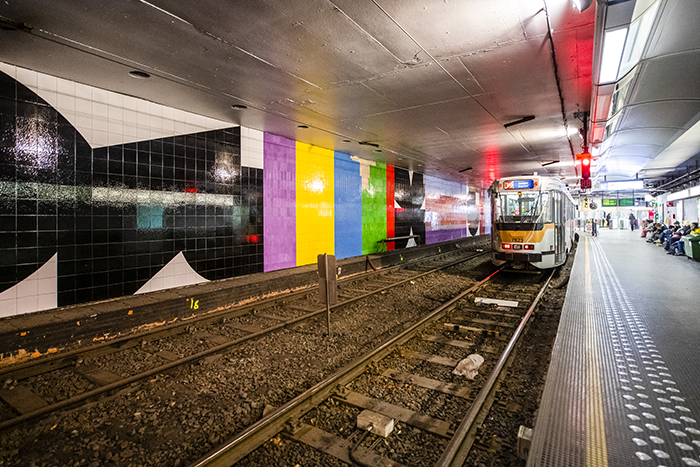Enamelled wall tiles (1976)
Over its 120 metres, “Rythme bruxellois” is an energetic alternation of colours and shapes. Within the three dimensions of the architectural space, the wall is covered in living contrasts of shapes and colours. Each part of this composition takes part in the whole but retains its own individuality. With this work of art, Jo Delahaut underlines simplicity and rejects - in one movement - complicated and unusual constructions. The brightly coloured parts alternate with compositions in black and white, whereas yellow, purple, blue, red and green of different widths repeat successively in horizontal, vertical or curved strips. The work of art is made of solid materials that are resistant to temperature variations and humidity, and can easily be washed so that dust and dirt can be removed.
List of links
JO DELAHAUT (1911 – 1992)
Jo Delahaut studied at the Academy of Liège. He also studied for a doctorate in history of art at the University of Liège. In the 1940s he was mainly influenced by the works of Auguste Herbin (1882-1960). Among the group of painters which set up the “Jeune Peinture Belge” (Young Belgian painting), Jo Delahaut was the first to exhibit non-figurative geometric compositions. He was the promoter and spokesman for the movement. Order, symmetrical construction, pure rhythm, serenity and a monumental appearance characterise his works. He wanted art to be incorporated into everyday surroundings in order to help people to free themselves from the past and adapt to everyday life. Jo Delahaut was a member of the “Réalités Nouvelles” (New Realities) in Paris in 1946, of “La Jeune Peinture Belge” in Brussels in 1947, a founding member of the Belgian group “Art Abstrait” in 1952, and co-author of “Manifeste Spatialiste” (Spatialist Manifesto) in 1954 together with Pol Bury (1922).
PICTURE

 Twitter
Twitter